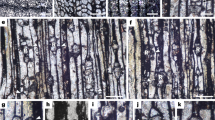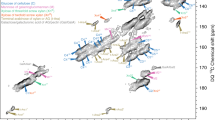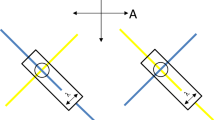Abstract
DURING the past thirteen years the finer detail of structure in conifer tracheids has been the subject of some controversy1,2,3,4. This has centred round the fact that when transverse sections, of conifer wood are examined between crossed Nicols three layers can be distinguished in the secondary wall of a tracheid, an outer and an inner layer which are bright, and a central layer, much thicker in late wood than the other two, which is dark. A similar behaviour is observed in cross-sections of wood fibres and is shown in the case of two isolated fibres of Nothofagus cunninghami in Fig. 1. On the basis of observations such as the run of striations in surface view, the orientation of crystals grown in the wall and the features associated with fungal attack, Bailey and his collaborators have claimed that the optical heterogeneity is due to different orientation of the cellulose ‘micelles’ in the three layers; in that while the micelles in the dark layer are orientated in a steep spiral, those in the outer and inner layers lie more or less transversely1 or, in later papers, at angles between 45° and 90° to the length of the cell3,5. The case where the micelles in the outer layer are orientated transversely and those in the middle layer longitudinally is shown diagrammatically in Fig. 2 (a). On the other hand, Preston2,4,6,7, criticizing the validity of the use of evidence obtained from swollen or otherwise distorted walls and basing his conclusions only on X-ray and optical examination of undistorted material, has maintained that the optical heterogeneity is to be explained largely by a pronounced difference in angular dispersion between the layers (Fig. 2b); and that, further, any wall layers with transverse orientation can only be present to an extent so small as to give no record on the X-ray diagrams of conifer wood7 and to cause no disturbance in the optical properties of walls in surface view7. The apparently contradictory X-ray evidence brought forward by Bailey and Berkeley3 was completely disposed of as an error in interpretation6, and it seemed at that time that the case was at last clear so far as the physical evidence went.
This is a preview of subscription content, access via your institution
Access options
Subscribe to this journal
Receive 51 print issues and online access
$199.00 per year
only $3.90 per issue
Buy this article
- Purchase on Springer Link
- Instant access to full article PDF
Prices may be subject to local taxes which are calculated during checkout
Similar content being viewed by others
References
Kerr, T., and Bailey, I. W., J. Arnold Arboretum, 15, 327 (1934).
Preston, R. D., Phil. Trans. Roy. Soc., B 224, 131 (1934).
Bailey, I. W., and Berkeley, E. E., Amer. J. Bot., 29, 231 (1942).
Preston, R. D., Proc. Leeds Phil. Soc., 3, No. 9, 552 (1939).
Bailey, I. W., and Vestal, M. R., J. Arnold Arboretum, 18, 185 (1937).
Preston, R. D., Proc. Roy. Soc., B 133, 327 (1943).
Preston, R. D., Proc. Roy. Soc., B 134, 202 (1947).
Wardrop, A. B., Internal Report Division Forest Products, C.S.I.R., Melbourne, Australia (1946).
Coppick, S., and Fowler, W. T., Paper Trade J., 109, T.S. 135 (1939).
Wardrop, A. B., and Dadswell, H. E., in the press.
Author information
Authors and Affiliations
Rights and permissions
About this article
Cite this article
WARDROP, A., PRESTON, R. Organisation of the Cell Walls of Tracheids and Wood Fibres. Nature 160, 911–913 (1947). https://doi.org/10.1038/160911a0
Issue Date:
DOI: https://doi.org/10.1038/160911a0
This article is cited by
-
Application of X-ray diffraction to assess the microfibril angle of green and dry Eucalyptus grandis wood
Trees (2022)
-
Factors affecting the hygroexpansion of paper
Journal of Materials Science (2018)
-
Modelling microfibril angle variation in New Zealand-grown radiata pine
New Zealand Journal of Forestry Science (2014)
-
Modelling of effects of ultrastructural morphology on the hygroelastic properties of wood fibres
Journal of Materials Science (2007)
-
Ultrastructure?Critical domain for wood behavior
Wood Science and Technology (1981)
Comments
By submitting a comment you agree to abide by our Terms and Community Guidelines. If you find something abusive or that does not comply with our terms or guidelines please flag it as inappropriate.



